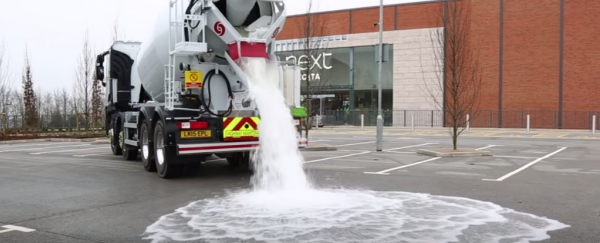During the first few weeks of August 2007, the American Midwest was devastated by heavy and repeated flash flooding as a result of Hurricane Dean and Tropical Storm Erin dumping massive amounts of rain on several states. And of the US$549 million or so in property damage that came from it, more than two-thirds was caused by water running off pavements or overflowing from drainage systems. So what's the solution?
We need to prevent all that water from accumulating on the surface of our roads and footpaths, so Tarmac in the UK has invented Topmix Permeable, a new type of porous concrete that can absorb up to 4,000 litres of water in the first 60 seconds, and an average of 600 litres per minute, per metre squared.
The concrete works by having a permeable layer on the surface, made up of relatively large pebbles through which water can drain almost instantly. This is followed by an 'attenuation layer', which feeds the water into a drainage system that connects with the city's groundwater reservoirs. So don't worry, all the water you can see pouring out in the video isn't being wasted - it's being fed straight back into the system for irrigation, drinking water, swimming pools, and firefighting purposes.
While permeable concrete has been around for the past 50 years, it's mostly been used under pavements to help with drainage, so the researchers at Tarmac figured out how to make a surface layer version of it that's capable of withstanding the weight of heavy traffic.
Not only can the super-absorbent concrete be used in conjuction with existing concrete - cities can install it so the runoff from regular concrete is fed into the Topmix Permeable - but it will also be significantly cooler than regular concrete during the hottest months of the year. "During periods of rising temperatures and intense rainfall, water stored within the system evaporates creating a cooling effect reducing surface temperatures," Tarmac said in a press statement.
The only downside? If that water happens to freeze, the entire system would be destroyed, so the concrete can only be used in places where temperatures are never likely to dip that low, as Tech Insider explains in the video below:
